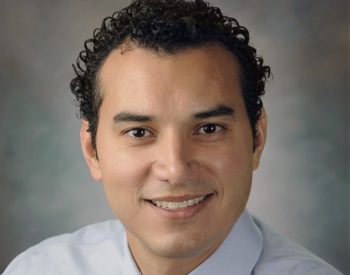Multisystem inflammatory syndrome in children (MIS-C), believed to be linked to COVID-19, damages the heart to such an extent that some children will need lifelong monitoring and interventions, said the senior author of a medical literature review published Sept. 4 in EClinicalMedicine, a journal of The Lancet.
Case studies also show MIS-C can strike seemingly healthy children without warning three or four weeks after asymptomatic infections, said Alvaro Moreira, MD, MSc, of The University of Texas Health Science Center at San Antonio. Dr. Moreira, a neonatologist, is an assistant professor of pediatrics in the university’s Joe R. and Teresa Lozano Long School of Medicine.

“According to the literature, children did not need to exhibit the classic upper respiratory symptoms of COVID-19 to develop MIS-C, which is frightening,” Dr. Moreira said. “Children might have no symptoms, no one knew they had the disease, and a few weeks later, they may develop this exaggerated inflammation in the body.”
Findings
The team reviewed 662 MIS-C cases reported worldwide between Jan. 1 and July 25. Among the findings:
- 71% of the children were admitted to the intensive care unit (ICU).
- 60% presented with shock.
- Average length of stay in the hospital was 7.9 days.
- 100% had fever, 73.7% had abdominal pain or diarrhea, and 68.3% suffered vomiting.
- 90% had an echocardiogram (EKG) test and 54% of the results were abnormal.
- 22.2% of the children required mechanical ventilation.
- 4.4% required extracorporeal membrane oxygenation (ECMO).
- 11 children died.
“This is a new childhood disease that is believed to be associated with SARS-CoV-2,” Dr. Moreira said. “It can be lethal because it affects multiple organ systems. Whether it be the heart and the lungs, the gastrointestinal system or the neurologic system, it has so many different faces that initially it was challenging for clinicians to understand.”
The amount of inflammation in MIS-C surpasses two similar pediatric conditions, Kawasaki disease and toxic shock syndrome. “The saving grace is that treating these patients with therapies commonly used for Kawasaki – immunoglobulin and glucocorticosteroids – has been effective,” Dr. Moreira said.
Cardiac abnormalities
Most of the 662 children suffered cardiac involvement as indicated by markers such as troponin, which is used with great accuracy in adults to diagnose heart attacks.
“Almost 90% of the children (581) underwent an echocardiogram because they had such a significant cardiac manifestation of the disease,” Dr. Moreira said.
The damage included:
- Dilation of coronary blood vessels, a phenomenon also seen in Kawasaki disease.
- Depressed ejection fraction, indicating a reduced ability for the heart to pump oxygenated blood to the tissues of the body.
- Almost 10% of children had an aneurysm of a coronary vessel. “This is a localized stretching or ballooning of the blood vessel that can be measured on an ultrasound of the heart,” Dr. Moreira said.
Children with an aneurysm are at the most risk of a future event. “These are children who are going to require significant observation and follow-up with multiple ultrasounds to see if this is going to resolve or if this is something they will have for the rest of their lives,” Dr. Moreira said.
“And that’s catastrophic to a parent who had a previously healthy child and then he/she is in the very small percentage of individuals who developed MIS-C after COVID-19 infection,” he said.
Underlying conditions
Another finding from the case studies: Almost half of patients who had MIS-C had an underlying medical condition, and of those, half of the individuals were obese or overweight.
“Generally, in both adults and children, we are seeing that patients who are obese will have a worse outcome,” Dr. Moreira said.
When compared to the initial COVID-19 infection, inflammatory markers in MIS-C were far more abnormal. For instance, troponin, the marker used in adults to diagnose heart attacks, was 50 times its normal level in children with MIS-C.
“Evidence suggests that children with MIS-C have immense inflammation and potential tissue injury to the heart, and we will need to follow these children closely to understand what implications they may have in the long term,” Dr. Moreira said.
Researchers at Texas Children’s Hospital in Houston, Georgetown University, the National Institutes of Health and the University of Pennsylvania joined Dr. Moreira in conducting this literature review.
Multisystem inflammatory syndrome in children: a systematic review
Mubbasheer Ahmed, Shailesh Advani, Axel Moreira, Sarah Zoretic, John Martinez, Kevin Chorath, Sebastian Acosta, Rija Naqvi, Finn Burmeister-Morton, Fiona Burmeister, Aina Tarriela, Matthew Petershack, Mary Evans, Ansel Hoang, Karthik Rajasekaran, Sunil Ahuja and Alvaro Moreira
First published: Sept. 4, 2020, EClinicalMedicine
https://doi.org/10.1016/j.eclinm.2020.100527
The Long School of Medicine at The University of Texas Health Science Center at San Antonio is named for Texas philanthropists Joe R. and Teresa Lozano Long. The school is the largest educator of physicians in South Texas, many of whom remain in San Antonio and the region to practice medicine. The school teaches more than 900 students and trains 800 residents each year. As a beacon of multicultural sensitivity, the school annually exceeds the national medical school average of Hispanic students enrolled. The school’s clinical practice is the largest multidisciplinary medical group in South Texas with 850 physicians in more than 100 specialties. The school has a highly productive research enterprise where world leaders in Alzheimer’s disease, diabetes, cancer, aging, heart disease, kidney disease and many other fields are translating molecular discoveries into new therapies. The Long School of Medicine is home to a National Cancer Institute-designated cancer center known for prolific clinical trials and drug development programs, as well as a world-renowned center for aging and related diseases.
The University of Texas Health Science Center at San Antonio, also referred to as UT Health San Antonio, is one of the country’s leading health sciences universities and is designated as a Hispanic-Serving Institution by the U.S. Department of Education. With missions of teaching, research, patient care and community engagement, its schools of medicine, nursing, dentistry, health professions and graduate biomedical sciences have graduated more than 37,000 alumni who are leading change, advancing their fields, and renewing hope for patients and their families throughout South Texas and the world. To learn about the many ways “We make lives better®,” visit www.uthscsa.edu.
Stay connected with The University of Texas Health Science Center at San Antonio on Facebook, Twitter, LinkedIn, Instagram and YouTube.
To see how we are battling COVID-19, read inspiring stories on Impact.


